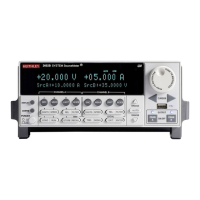11-14 Triggering 2400 Series SourceMeter
®
User’s Manual
TLINk — Event detection occurs when an input trigger via the Trigger Link input line is
received. See “Trigger link,” page 11-19, for more information. With TLINk selected, you
can loop around the Arm Event Detector by setting the event detector bypass
(ARM:DIRection) to SOURce.
NSTest — Event detection occurs when the start-of-test (SOT) line of the Digital I/O port
is pulsed low. This pulse is received from the handler to start limit testing. (See Section 12,
“Limit Testing,” and Section 13, “Digital I/O port.”)
PSTest — Event detection occurs when the start-of-test (SOT) line of the Digital I/O port
is pulsed high. This pulse is received from the handler to start limit testing. (See
Section 12, “Limit Testing,” and Section 13, “Digital I/O port.”)
BSTest — Event detection occurs when the start-of-test (SOT) line of the Digital I/O port
is pulsed either high or low. This pulse is received from the handler to start limit testing.
See Section 12 and Section 13.
NOTE NSTest, PSTest, and BSTest can be used only at the beginning of a sweep and
should not be used to trigger each point in a sweep.
Trigger layer
The Trigger Layer uses three event detectors; one for each action (Source, Delay, and
Measure).
Event detector bypass — As shown in Figure 11-3, there is a bypass
(TRIGger:DIRection) for the Source Event Detector. This bypass is in effect only if
TLINk is the selected Trigger-In Source. With this event detector bypass set to SOURce,
operation will proceed around the Source Event Detector.
The programmable trigger-in sources for the Trigger Layer are described as follows:
IMMediate — With Immediate selected, event detection for the three detectors is satisfied
immediately. Operation proceeds through the Trigger Layer to perform the Source, Delay,
and Measure actions.
TLINk — With TLINk selected, event detection at each enabled detector occurs when an
input trigger via the Trigger Link input line is received. A detector is enabled by including
its parameter name with the TRIGger:INPut command.
For example, to enable the Delay Event Detector and Measure Event Detector, the follow-
ing command must be sent:
TRIGger:INPut DELay, SENSe
The above command disables the Source Event Detector since its parameter name
(SOURce) is not included in the parameter list.
With the Source Event Detector disabled, operation will not hold up. It will continue and
perform the Source Action. Operation will hold up at the Delay Event Detector until an
input trigger is received, and then it will hold up at the Measure Event Detector until
another input trigger is received.
Artisan Technology Group - Quality Instrumentation ... Guaranteed | (888) 88-SOURCE | www.artisantg.com

